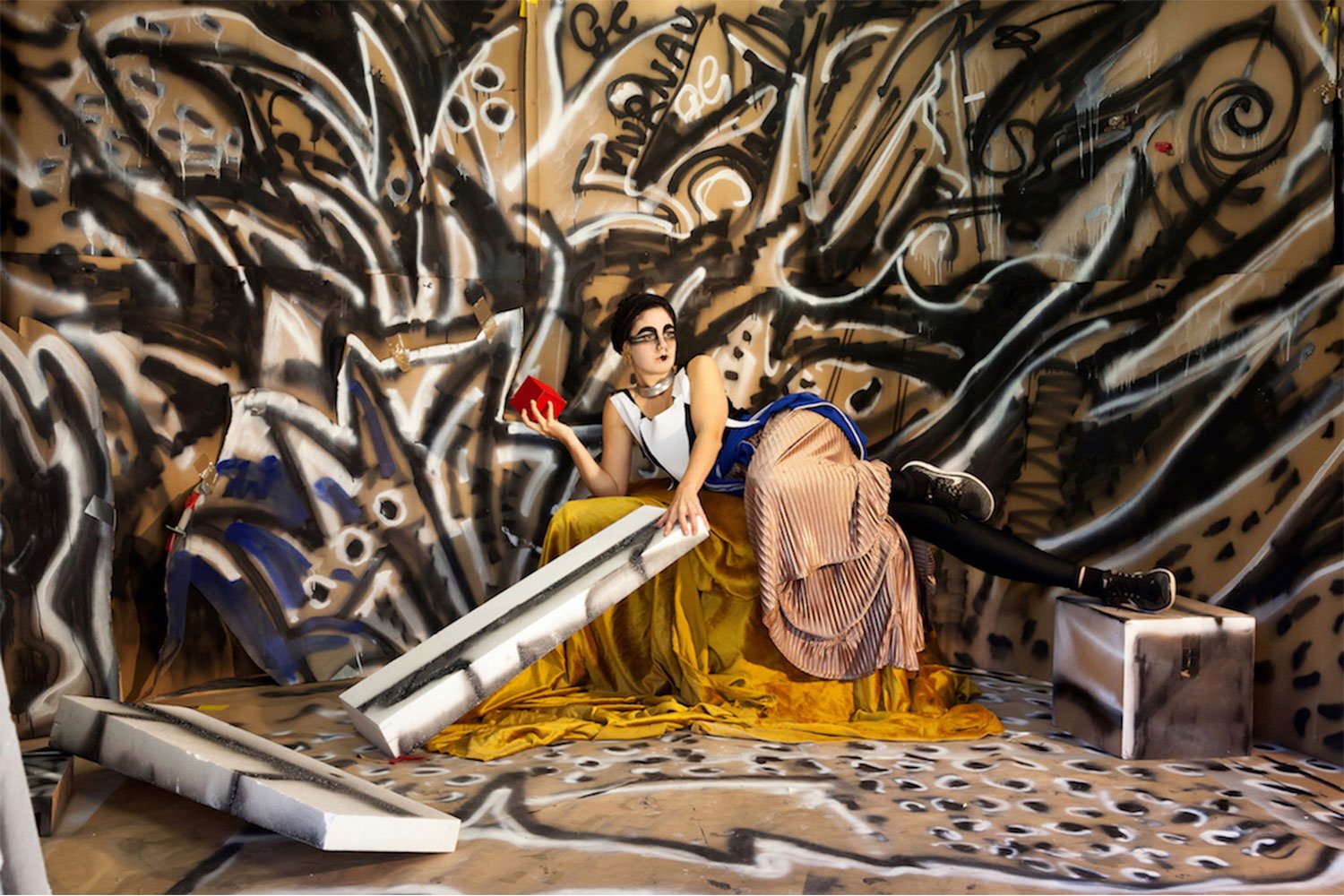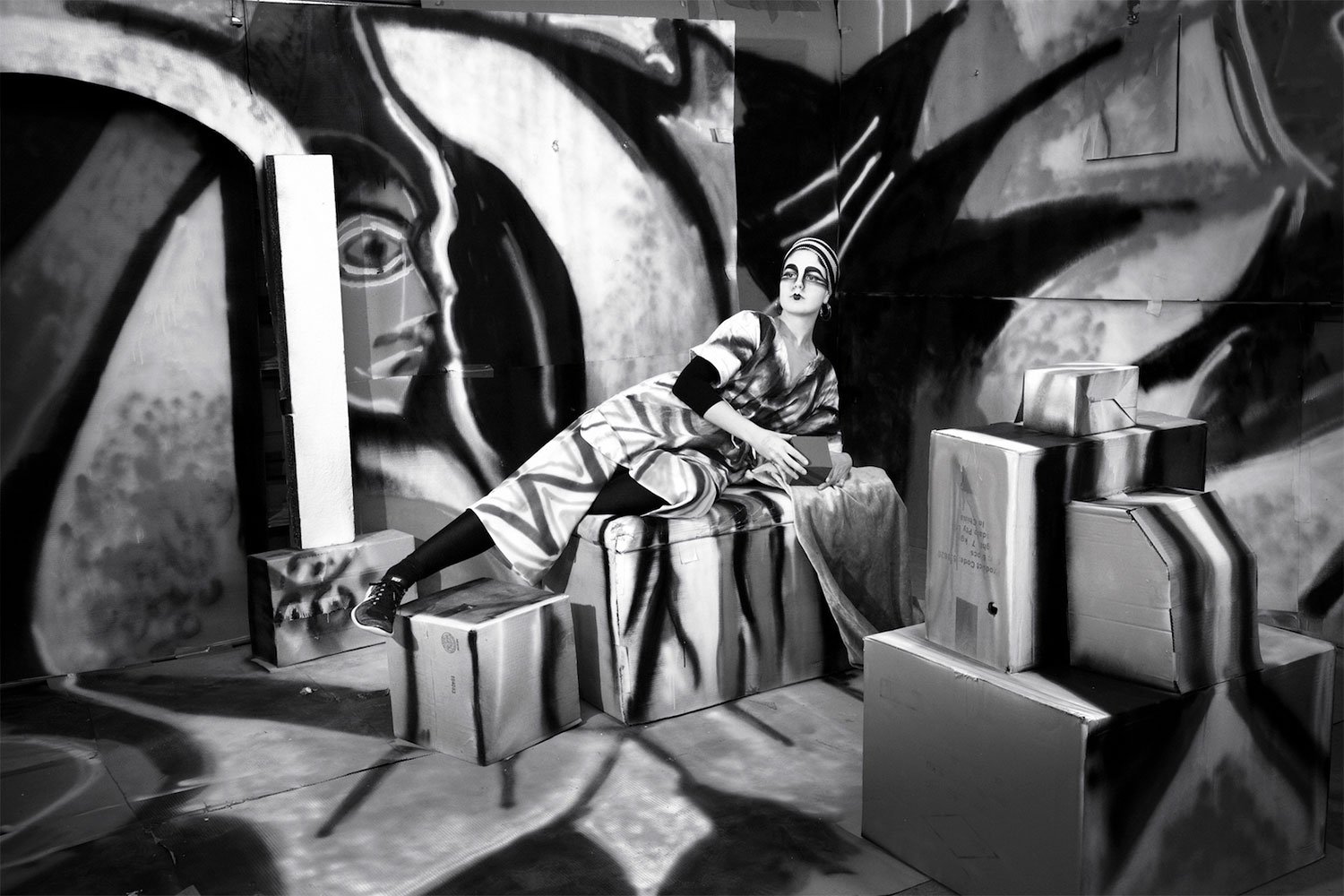Visual artist Georgina Cue started building and photographing sets for her film vignettes after moving back to her family home, where she set up a studio in the garage. This triggered a radical shift in her practice.
Before that, Georgina sculptured installations from embroidered textiles and carved timber but grew tired of using the same mediums, and the prescriptive routine that her art-making had become.
‘There is a cohesiveness that is expected from your work in order for you to be considered a professional artist,’ she explains. ‘I can understand why that is a requirement, because if a curator is going to ask you to do a big project, they want to see continuity in what you produce. In a way, you are rewarded for making the same thing, which is why it can be hard to break out of a cycle of practice.’
Since moving away from textiles and installation and into digital media, Georgina has become known for her avant-garde photographs that often feature the artist herself – an abstract style of autobiographical portrait inspired by early 1930s and ‘40s Film Noir production shots.
Her most recent series, Scenes, references the Bauhaus Era with ‘much more colour, and figurative motifs’ instead of her own image that represent the presence of a woman in a ‘less Cindy Sherman style of self-portraiture’.
Scenes was shown earlier this month, in her first solo show with Neon Parc at their Melbourne city location.

What inspired the imagery of Scenes?
Over the last few years, I have been combining photography with painting as well as performance and self-portraiture and looking at how different light-effects and artifice translate into real life. Scenes is an exodus of a series that began in 2016, when I was creating homemade silent films, and is inspired by a lot of Bauhaus era imagery; including the work of Oscar Shelmma (who did the Triadisches Ballett) and Modernist painters.
How did the idea to build sets occur specifically?
I had a big shift in my practice when I moved back home and started working from my parents’ garage. I started making video vignettes using an app on my phone and building the sets for them, and one day a friend was over and I asked him to take a photograph of me in one of the sets. Eventually, I found it a lot more fascinating than making the films themselves.
Had you worked with photography before that?
I’ve always been interested in film and photography — particularly Film Noir. When I was an undergrad there weren’t many online databases so I spent a lot of time at the Biomedical Department at Melbourne University gathering images that I thought were really striking. I was drawn to a lot of crime scene photos from the early 20th century, and a book that had photographs taken by police in the 1920s, called ‘City of Shadows.’ It was obviously quite graphic, but I loved the sumptuous interiors that had these horrific events happen there. I also liked the lighting effects and the narrative style that you could observe. From that, I created a body of work using embroidery which re-imagined those settings. I didn’t have any training in embroidery prior to that, so it was very experimental — they looked more like drawings.

Interesting. So how long were you doing that for?
I worked with textiles and sculpture for about six to eight years.
And what triggered the shift?
Definitely moving back into my parent’s garage. I think the studio had become too much of a formal space for me and how I worked became very prescriptive. It was like: ‘Oh, I’ll embroider this or I’ll embroider that.’ Once I moved out of there I became far more experimental and could shed all of my assumptions about what my work was, which I think can happen often with artists.
Would you say that restrictiveness carried through from learning within an institution?
I don’t think it necessarily comes from art school. I think a lot of it is self-imposed, and to do with my expectations about what I should be doing. In a way, you are rewarded for making the same thing, which is why it can be a lot harder to break out of a cycle of practice. Having said that, constantly reinventing yourself can also become a stylistic entrapment.
Why do you think that is such a trend in visual art?
I think that if you have created something that is interesting to people then you are expected to continue making the same kind of work. It is also so hard to establish yourself, let alone to gain momentum within that and get support.

So what has been the most challenging aspect of your career so far?
I think working around my perfectionism (laughs). I have quite an obsessive nature, which I have to manoeuvre around in order to make work that is interesting—because I find perfectionism quite boring.
Creatives have such a personalised idea of perfection! Where would you like to take your practice next?
I’d like to continue working with photography for now. I have a solo show coming up next year at Gertrude Glasshouse, because I am a Gertrude Contemporary artist at the moment. I think I am going to be pushing more toward still-life assemblages and less self-portraiture; similar to the promo image for Neon Parc. Definitely more experimentation with scale and colour, and the camera as well – at the moment it is quite a fixed perspective.
Curious for more? You can view Georgina’s scenes via this page.

